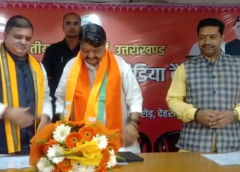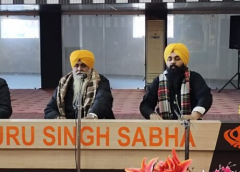Dehradun- 28 April 2022- On the 14th day of Virasat, held in the B.R. Ambedkar Stadium, Kaulagarh Road, the Prize Distribution Ceremony took place along with enthraling performances by Rishika Mishra and Sanjukta Das. In the Sit And Draw competition, Anurag Ramola from KV ONGC bagged the First Prize, Kashish Yadav from the Asian School won the Second Prize, and Sana Mehra from Team BTDT won the Third Prize.
Saumya Makreti from Jaswant Modern School won the First Prize in the Photography Competition. Ishwit Uniyal from Doon International School received the Second, and Khushi Bisht from Him Jyoti School received the Third. In the Heritage Treasure Hunt Competition- Vedanta Ohri, Shreya Chhetri, Saumya Makreti, Mansi from Jaswant Modern School bagged the First Prize; The Second and Third Prizes went to Doon International School and Jaswant Modern School, respectively.
At night, Rishika Mishra, an emerging artist representing the traditional Kathak of Banaras Gharana showcased her talent. She comes from the legendary family of late Acharya Pt. Sukhdeo Maharaj. Her mother, Jayanti Mala, is a world-renowned Kathak Dancer. Rishika is the granddaughter of Kathak Queen Sitara Devi, and she got her first training at the age of three years from her mother and grandmother.
Rishika has immense command over the mathematical calculations involved in Kathak and mastered it at a very young age. Awards and Achievements: Rishika has performed in various festivals like Haridas Sammelan, Sursingar Samsad, Iskcon Festival, and Mysore Festival. She has also toured Overseas Concert Performances. She does many types of Kathak Dances such as mythological temple style, Tandav, lcishya, Pradosh & Natwari.
She has performed Ekaki Nritya Natika, Sampoorna Ramayan, Geeta Updesh, Om Nama Shivaya, Shiv Puraan, Gayatri Mahima , Nao Durga Saptapti, Vishnu Puraan Mahima. She also does the Mughal style of dancing like Darberi Nritya. Rishika Mishra, like her mother & grandmother, is very versatile in Abhinaya & laikari; the clarity of her hand mudras and movements are just excellent. Her Kathak dance traditional and pure chakras are very clear cut and neat. She is a graceful dancer, combining tradition and modernity in her presentations. She has directed Bombay T.V. Krisan Leela Dance and Maneka dance ballet. Presently, she is doing the drama of Great Amarapali and Vasant Sena.
She started her performance with the Saraswati Vandhana, followed by the traditional Teen Taal- Toda/Tihayi/Paran/Padanth. Later, she performed the Durga Stuti- Mahishasura Mardini, Mahaleela- Talwar Gat composed by Shambhu Maharaj and Banarasi Dadra. Along with Rishika Mishra, Shubh Maharaj, Paneshu Maharaj, and Kushal Krishna were on Tabla, Shrimati Jayanti Mala on Padhant, and Gaurav Mishra was on the harmonium and gave the vocals.
The thumri is another North Indian vocal form based on the romantic-devotional literature inspired by the bhakti movement. The text is usually derived from the Radha-Krishna theme and is primarily important. The term “thumri” is derived from the Hindi verb thumakna, which means “to walk with a dancing gait so that the ankle-bells tinkle.” It was developed in the 19th century at the court of Lucknow’s ruler Wajid Ali Shah. The form is, thus, connected with dance, dramatic gestures, mild eroticism, evocative love poetry and folk songs.
Later, Sanjukta Das performed. She obtained her M.Sc. Degree in Economics from the University of Calcutta. She is a Music Scholar at West Bengal State Music Academy, Kolkata. She is an Anchor of Doordarshan Kendra, Kolkata. She trained under Ustad Raza Ali Khan. She is also a pupil of Vidushi Dalia Raut, renowned Thumri and Dadra exponent. She is currently receiving her training in Rabindra Sangeet from Prabuddha Raha.
Previously she was under the able guidance of Shyamasree Dasgupta, a senior disciple of Kanika Bandopadhyay, Apala Basu and Rajeshwar Bhattacharya. Sanjukta began her singing career in 1998 as a child artist of Khayal, Rabindra Sangeet, and Nazrul Geeti in Shishumahal, followed by Galpo Dadur Ashor and then Yuvavani in the streams of Ragpradhan and Adhunik of All India Radio. During Sanjukta Ji’s performance, Mithilesh Jha was on tabla, Zakir Dholpuri was on Harmonium and on tanpura was Paras Upadhyay. REACH was established in 1995 in Dehradun and has continued to organise the Virasat Festival ever since.
Their aim is simply to preserve the value and essence of Indian art, culture and heritage and to bring these cultural values to the masses. Virasat has been instrumental in reviving many rural arts which were once on the verge of extinction due to a lack of an audience. The festival has played an essential role in preserving and reviving our village’s traditions, music, dance, crafts, painting, sculpture, theatre, storytelling, traditional cuisine, etc. and bringing them into practice in these modern times, because of which our classical and contemporary arts have started being recognised once again.



